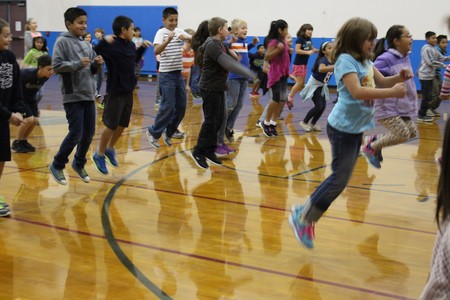 This post reflects a compensated editorial partnership with Voices for Healthy Kids, a joint initiative of the American Heart Association and Robert Wood Johnson Foundation.
This post reflects a compensated editorial partnership with Voices for Healthy Kids, a joint initiative of the American Heart Association and Robert Wood Johnson Foundation.
Imagine you are 11. Your body is being possessed. One minute, you are a kid, wanting your
stuffed animal at bedtime. The next minute, you are listening to the news and worrying about Russians taking over our elections. Your body, it’s antsy. It is changing fast. Your life is full of activities, confusing social dynamics, and people telling you what to do, and when.
Then you get to PE.
PE, for many kids, is the release valve. It is where they can move their bodies and shake off the math lesson, the cruel joke, or the latest test. PE can also be where they gain confidence, learn how to take care of their bodies, and where they learn how to play with other kids.
As a teacher, I saw how different students acted on days with and without a PE class. Aside from the occasional post PE argument about who won, students came back to class with bodies and minds ready to settle back into learning. The days with no PE, or the worst, indoor recess?
No so much.
A brain needs movement breaks. With a packed curriculum, standardized testing, and increasing pressures, this can be hard for the teacher to provide. That is why recess and PE classes are so critical.
Research shows kids need 60 minutes of physical activity per day and PE programs help our kids get to this minimum for their health and wellbeing. PE addresses the needs of the whole child, positively impacting their physical, mental, and emotional health.
Here’s the problem: Only 4% of elementary schools, 8% of middle schools, and 2% of high schools provide daily PE or its equivalent for the entire school year. How does that impact student learning, wellbeing, and their overall health? According to a report by University of Texas School of Public Health, kids need PE to be treated like a core subject like math or literacy:
“It is as important because it affects kids’ health, cognitive function and overall development. Physical activity improves kids’ fitness, lowers their risk of obesity and type 2 diabetes and helps build strong bones and muscles. Children who are more active have greater attention spans and better academic performance, the report says.”
And the opportunities are far from equal.
Many schools lack resources for PE. Kids shouldn’t have to miss out on the benefits of PE because of where they live and the school they attend.
We have a real chance to impact student health with the new ESSA law (Every Student Succeeds Act). In this new federal education law, all states must develop a comprehensive plan to ensure all students receive a fair, equitable, and high-quality education. I think physical education to be included in every state’s ESSA plans.
And here is the golden opportunity: unlike previous federal education law, ESSA includes physical education (PE) and improving health– -so this means that for the first time ever, health and PE have access to significant federal funding!
Don’t get too excited. The inclusion of health and PE in ESSA is not a mandate. We need to advocate for daily PE to be included as a core component in ESSA plans so that money can be accessed for PE. If PE is not included in the plan, it won’t have access to funding.
So, what can you do? Ask that your state includes PE in their new ESSA plans. Discover ways to increase PE in your community here and protect PE by joining the PE Action Team! Stay connected to this campaign by following on Twitter, Facebook, and using the handle #ProtectPE.
Let’s work together to raise healthier, active kids!

